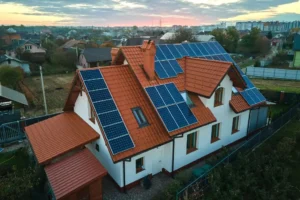Athletic facilities aim to enhance performance and well-being, with energy efficiency playing a vital role. The link between a building’s environment and athlete health is profound. Inefficient energy systems can impact air quality, temperature, and humidity, affecting athletes’ performance. Energy waste can pose health risks with long-term consequences. Exploring the importance of energy efficiency upgrades raises the question: how do healthy buildings contribute to the well-being of athletes?
Key Takeaways
- Energy efficiency upgrades in athletic facilities create ideal performance conditions, supporting athlete well-being and peak performance.
- Inadequately designed buildings harbor hidden health risks, including airborne pollutants, inadequate ventilation, and excessive humidity.
- Energy-efficient systems, such as advanced ventilation and natural lighting, promote athlete well-being and reduce health risks.
- Wellness-focused design principles and energy-efficient systems transform facilities into ideal environments, enhancing athlete performance and overall health.
- Sustainable practices in athletic facilities reduce ecological impact, conserve resources, and create a healthier environment, fostering a sense of community.
Energy Inefficiencies Affect Athlete Performance
Often, energy wastage in athletic facilities can have a significant impact on athlete performance, as inadequately designed or poorly maintained buildings can lead to suboptimal environmental conditions that hinder athletes’ ability to perform at their best. The importance of energy efficiency upgrades lies in creating ideal conditions that support athlete well-being and peak performance.
The Hidden Health Risks of Inefficient Buildings
Inadequately designed or poorly maintained athletic facilities can harbor hidden health risks, including airborne pollutants, inadequate ventilation, and excessive humidity, which can compromise athlete health and well-being. These risks can lead to:
- Respiratory issues from poor air quality
- Heat-related illnesses from inadequate ventilation
- Skin infections from excessive humidity
- Cardiovascular problems from poor indoor air quality
Understanding these risks is essential for creating healthy environments that support athlete well-being and performance, highlighting the Importance of Energy Efficiency Upgrades.
Upgrading to Wellness-Focused Facilities
By integrating wellness-focused design principles and energy-efficient systems, athletic facilities can be transformed into ideal environments that support the overall well-being of athletes. This harmonious blend of design and technology empowers athletes to thrive in spaces that prioritize their health and performance.
- Natural Light: Abundant natural light promotes vitamin D production and enhances mood.
- Air Quality: Advanced ventilation systems maintain ideal indoor air quality.
- Acoustic Comfort: Sound-absorbing materials minimize distractions and foster focus.
- Thermal Comfort: Precise temperature control guarantees optimal performance conditions.
A Healthier Tomorrow Through Sustainability
Sustainable practices in athletic facilities can significantly reduce ecological impact, paving the way for a healthier tomorrow. By incorporating the importance of energy efficiency upgrades, facilities can minimize their carbon footprint, conserve resources, and create a healthier environment for athletes and spectators alike. This synergy between sustainability and wellness nurtures a sense of community and promotes shared responsibility.

Frequently Asked Questions
What Is the ROI on Energy Efficiency Upgrades for Athletic Facilities?
The ROI on energy efficiency upgrades for athletic facilities typically ranges from 10% to 30%, depending on the type of upgrade, facility size, and location, with LED lighting and HVAC system upgrades often yielding the highest returns.
How Do Energy-Efficient Buildings Impact Athlete Mental Health?
Energy-efficient buildings positively impact athlete mental health by providing a comfortable, stress-reducing environment, which boosts focus, mood, and overall well-being, leading to improved athletic performance and overall success.
Can Energy-Efficient Design Features Be Added to Existing Buildings?
Yes, energy-efficient design features can be retrofitted into existing buildings through targeted upgrades, such as installing LED lighting, optimizing HVAC systems, and incorporating renewable energy sources, to improve overall building performance and occupant well-being.
What Are the Most Energy-Intensive Systems in Athletic Facilities?
In athletic facilities, the most energy-intensive systems are usually heating, ventilation, and air conditioning (HVAC), lighting, and refrigeration systems, which can make up to 70% of total energy consumption, offering opportunities for energy-efficient upgrades and cost savings.
Do Energy-Efficient Upgrades Affect the Overall Aesthetic of a Building?
Energy-efficient upgrades can improve, rather than detract from, a building’s aesthetic appeal, as modern sustainable design often incorporates sleek, contemporary features that elevate both functionality and visual appeal.
Conclusion
In summary, energy efficiency upgrades in athletic facilities are essential for optimizing athlete performance and well-being. By addressing energy wastage and incorporating wellness-focused design principles, facilities can reduce hidden health risks and promote a healthy environment. Through sustainable practices and advanced technologies, athletic facilities can prioritize athlete health and contribute to a healthier tomorrow. By integrating energy efficiency upgrades, facilities can cultivate a culture of wellness, community responsibility, and environmental stewardship.
You May Also Like:
